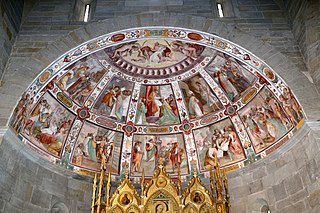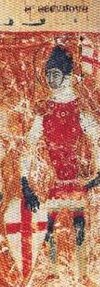
Pope Alexander I was the bishop of Rome from c. 107 to his death c. 115. The Holy See's Annuario Pontificio (2012) identifies him as a Roman who reigned from 108 or 109 to 116 or 119. Some believe he suffered martyrdom under the Roman emperor Trajan or Hadrian.
Saint Gavinus is a Christian saint who is greatly celebrated in Sardinia, Italy, as one of the Martyrs of Torres, along with his companions SS Protus, a bishop, and Januarius, a deacon.

Asti is a comune of 74,348 inhabitants (1-1-2021) located in the Piedmont region of northwestern Italy, about 55 kilometres east of Turin in the plain of the Tanaro River. It is the capital of the province of Asti and it is deemed to be the modern capital of Montferrat.

Bernardo Strozzi, named il Cappuccino and il Prete Genovese was an Italian Baroque painter and engraver. A canvas and fresco artist, his wide subject range included history, allegorical, genre and portrait paintings as well as still lifes. Born and initially mainly active in Genoa, he worked in Venice in the latter part of his career. His work exercised considerable influence on artistic developments in both cities. He is considered a principal founder of the Venetian Baroque style. His powerful art stands out by its rich and glowing colour and broad, energetic brushstrokes.

March 28 - Eastern Orthodox liturgical calendar - March 30

San Marzano Oliveto is a comune (municipality) in the Province of Asti in the Italian region Piedmont, located about 60 kilometres (37 mi) southeast of Turin and about 20 kilometres (12 mi) southeast of Asti.

Solutor, along with Octavius and Adventor, is patron saint of Turin.

Marcian of Tortona is a saint of Roman Catholic church. He is traditionally said to have been the first bishop of Tortona, in what is now north-western Italy, a post he held for forty-five years.

Eurosia is the patron saint of Jaca, a city in the province of Huesca of northeastern Spain, in the Pyrenees, the centre of her cult. In Spain, the "Fiesta de Santa Orosia" is celebrated on 25 June. Tradition states that she was born in Bayonne and died in 880, martyred by the Moors at Jaca.

Fidelis of Como was an Italian soldier-saint, according to Christian tradition.

Restituta is a Berber saint and martyr of the Roman Catholic and Eastern Orthodox Churches. She was said to have been born in Carthage or Teniza and martyred under Roman Emperor Diocletian. The location and date of her martyrdom are not precisely known. She sometimes is considered one of the Martyrs of Abitinae, Roman Province of Africa, a group of North Africans including Dativus, Saturninus, et alia, who were martyred in AD 304.
Saints Felinus and Gratian(us) (sometimes Gratinian(us)) (d. 250 AD) are venerated as martyrs by the Catholic and Eastern Orthodox churches. They are patron saints of Arona, near Milan, where their relics were enshrined.

Calimerius was an early bishop of Milan. He is honoured as a Saint in the Catholic and Eastern Orthodox churches and his feast day is on July 31.
Saint Calocerus was a 2nd-century Christian martyr. He was probably an officer in the Roman army under the Roman emperor Hadrian and was stationed in Brescia in Lombardy, Italy. His life and legend are associated with Saints Faustinus and Jovita, and according to tradition, all three saints were soldiers from Brescia.

Saint Romulus of Fiesole was bishop of Fiesole during the 1st century. He is venerated as the patron saint of Fiesole, Italy. Romulus was probably a local deacon, priest, or bishop of the 1st century.

Chiaffredo is venerated as the patron saint of Saluzzo, Italy. Tradition considers him a member of the Theban Legion, but instead of being martyred with this legion at Agaunum, he escaped to Piedmont and was martyred there.

The Palio di Asti is a traditional Italian festival of medieval origin that culminates with a bareback horse race.

Constantius is venerated as a member of the legendary Theban Legion. Similar to the cults of Chiaffredo at Crissolo, Bessus at Val Soana, Tegulus at Ivrea, Magnus at Castelmagno, and Dalmatius at Borgo San Dalmazzo, the cult of Constantius was linked with that of the Theban Legion to lend antiquity to a local saint about whom nothing was really known.

Vigilius of Trent is venerated as the patron saint and bishop of Trent. He should not be confused with the pope of the same name.

Asti Cathedral, the episcopal seat of the Diocese of Asti, is a Roman Catholic cathedral in Asti, Piedmont, Italy. It is dedicated to the Assumption of the Blessed Virgin Mary and to Saint Gotthard, and at 82m long and 24m in height and width, is one of the largest churches in Piedmont, the highest expression of Gothic architecture of the region, and among the best examples of Lombard Romanesque appreciable in northern Italy.


















